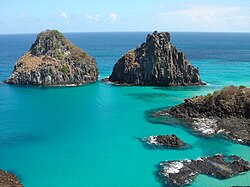жө·дёӢж°ҙиқ•жҙһжө·дёӢж°ҙиқ•жҙһпјҲиӢұиӘһпјҡAnchialine poolпјҢ/ЛҲГҰЕӢkiЙҷlaЙӘn/жҲ–/ЛҲГҰЕӢ.kiЙҷ.lin/пјүпјҢеҸҲзЁұжө·ж°ҙж№–пјҲиӢұиӘһпјҡMarine lakeпјүпјҢжҳҜең°еә•иҲҮжө·жҙӢзӣёйҖЈзҡ„е…§йҷёж°ҙй«”пјҢз”ұж–јеҸ—еҲ°йӣЁж°ҙгҖҒең°дёӢж°ҙеҸҠжҪ®жұҗеҪұйҹҝпјҢе…§йғЁеӯҳеңЁж·Ўж°ҙгҖҒеҚҠй№№ж°ҙеҸҠй№№ж°ҙдёҰдҫқз…§еҜҶеәҰеһӮзӣҙеҲҶеұӨпјҢдё»иҰҒеҲҶеёғж–јзҶұеё¶жҲ–дәһзҶұеё¶ең°еҚҖзҡ„е–Җж–Ҝзү№еҸҠзҒ«еұұең°еҪўгҖӮеӣ зӮәе…¶з’°еўғзҡ„зү№ж®ҠжҖ§пјҢе…¶е…§йғЁжңүжңүеҲҘж–јжө·жҙӢжҲ–ж№–жіҠзҡ„з”ҹж…Ӣзі»пјҢдёҰдё”ж“ҒжңүдёҖдәӣз”Іж®јйЎһзҡ„зү№жңүзЁ®з”ҹзү©пјҢдҫӢеҰӮеӨҸеЁҒеӨ·зҙ…иқҰгҖӮ[1] иӘһжәҗиӢұиӘһгҖҢanchialineгҖҚдёҖи©һз”ұиҚ·иҳӯеӢ•зү©еӯёе®¶еҲ©е…ӢВ·йңҚйҮҮж–Ҝж–ј1973е№ҙйҰ–еәҰжҸҗеҮәпјҢи©Іи©һз”ұеёҢиҮҳж–ҮгҖҢankhialosгҖҚиЎҚз”ҹиҖҢдҫҶпјҢж„ҸзӮәгҖҢжҝұжө·зҡ„гҖҚпјҢжңҖеҲқз”ЁдҫҶжҸҸиҝ°йҡЁи‘—жҪ®жұҗиө·иҗҪзҡ„йҷёдёҠй№№ж°ҙжұ пјҢ[иЁ» 1][2]1997е№ҙBrock, Richard E.е’ҢKam, Alan K.H.еҶҚж·»еҠ гҖҢж»ҝжҪ®жҷӮиҲҮе…¶д»–ж°ҙй«”еҲҶйӣўгҖҚзҡ„еҺҹеүҮгҖӮ[иЁ» 2][3]жӯӨеӨ–пјҢжө·ж°ҙж№–еүҮжҳҜе°Қж№–йқўијғеӨ§гҖҒдё”йҖҖжҪ®жҷӮеә•йғЁдёҚд№ҫж¶ёзҡ„жө·дёӢж°ҙиқ•жҙһзҡ„йҖҡдҝ—зЁұе‘јгҖӮ[4] еҪўжҲҗеҸҠеҲҶеёғ  жө·дёӢж°ҙиқ•жҙһдё»иҰҒеҲҶзӮәе…©йЎһпјҡзҹізҒ°еІ©иіӘеҸҠзҒ«жҲҗеІ©иіӘгҖӮеүҚиҖ…зӮәе–Җж–Ҝзү№ең°еҪўеӣ жІүж°ҙдҪңз”ЁеҪўжҲҗпјҲеҗҢжҷӮзӮәзҹізҒ°йҳұпјүпјҢеҸҲеӣ зҶұгҖҒдәһзҶұеё¶ең°еҚҖзҹізҒ°еІ©ең°еҪўијғзҷјйҒ”пјҢж•…жӯӨйЎһжө·дёӢж°ҙиқ•жҙһеҲҶеёғеӨҡдҪҚж–јзҶұеё¶еҸҠдәһзҶұеё¶пјҢдҫӢеҰӮзҢ¶еҠ ж•ҰеҚҠеі¶гҖҒеҠ еӢ’жҜ”зҫӨеі¶гҖҒең°дёӯжө·зҹізҒ°еІ©ең°еҚҖгҖҒеёӣзҗүзҫӨеі¶е’ҢеҚ°е°јзҫӨеі¶зӯүпјӣеҫҢиҖ…зӮәзҶ”еІ©з®Ўиў«жө·ж°ҙдҫөе…ҘпјҢеӨҡеҲҶеёғж–јзҒ«еұұеё¶пјҢдҫӢеҰӮеӨҸеЁҒеӨ·зҫӨеі¶гҖҒеҠ жӢүе·ҙе“ҘзҫӨеі¶гҖҒеҠ зҙҚеҲ©зҫӨеі¶е’Ңи–©ж‘©дәһзҫӨеі¶зӯүгҖӮ[4] з’°еўғеҸҠз”ҹж…Ӣ жҝұжө·ең°еҚҖзҡ„ең°дёӢж°ҙеұӨиҲҮжө·ж°ҙдёҰдёҚжңғеңЁжө·еІёз·ҡдәӨжңғпјҢиҖҢжҳҜеҪўжҲҗдёҖеҖӢйЎһдјјйҖҸйҸЎзҡ„ж§ӢйҖ пјҲж·Ўж°ҙйҖҸйҸЎй«”пјүпјҢдҫҶиҮӘйҷёең°зҡ„ж·Ўж°ҙжңғиҰҶи“ӢдҫҶиҮӘжө·жҙӢзҡ„й№№ж°ҙпјҢдёҰеңЁе…¶дәӨз•Ңиҷ•з”ўз”ҹй№ҪиәҚеұӨпјҢеҺҡеәҰе№ҫе…¬еҲҶиҮіе№ҫе…¬е°әдёҚзӯүгҖӮ[5]еңЁй№ҪиәҚеұӨдёӯй№ҪеәҰи®ҠеҢ–еҠҮзғҲпјҢеӨ§еӨҡз”ұеҚҠй№№ж°ҙе’Ңж·Ўж°ҙзө„жҲҗпјҢдё”еӣ еҜҶеәҰзҡ„и®ҠеҢ–дҪҝеҫ—еә•йғЁзҡ„й№№ж°ҙеёёе№ҙиҷ•ж–јдҪҺж°§з’°еўғдёӯпјҢеҚідҪҝеңЁжә«её¶зҡ„еҶ¬еӯЈпјҢж·Ўж°ҙзҡ„еҜҶеәҰд»Қијғжө·ж°ҙе°ҸгҖӮжӯӨеӨ–пјҢз”ұж–јеә•йғЁзҡ„зјәж°§з’°еўғпјҢиЎҢе…үеҗҲдҪңз”Ёд»ҘйҖІиЎҢеҲқзҙҡз”ҹз”ўзҡ„з”ҹзү©ијғе°‘пјҢеҸ–иҖҢд»Јд№Ӣзҡ„жҳҜзЎ«йӮ„еҺҹиҸҢйҖҸйҒҺе°Үж°ҙдёӯиұҗеҜҢзҡ„зЎ«еҢ–ж°«иҪүжҸӣзӮәзЎ«зҚІеҸ–жңүж©ҹзү©пјҢеә•йғЁзҡ„ж°ҙиіӘжңғијғй ӮйғЁж··жҝҒгҖӮ[6] жө·дёӢж°ҙиқ•жҙһзҡ„з”ҹзү©зө„жҲҗиҲҮжө·жҙӢйЎһдјјпјҢе…¶дёӯз”Іж®јйЎһзҡ„з”ҹзү©ијғзӮәиұҗеҜҢпјҢйҷӨдәҶж§іи¶із¶ұзҡ„з”ҹзү©еӨ–пјҲеңЁ1979е№ҙеүҚиў«иӘҚзӮәе·Іж»…зө•пјҢзҸҫеӯҳ28зЁ®пјҢжҙ»еҢ–зҹід№ӢдёҖпјүпјҢдәҰжңүж··и¶ізӣ®[7]гҖҒе№іи…ізӣ®[8][9]зҡ„зү№жңүзЁ®еӯҳеңЁпјӣ然иҖҢйғЁеҲҶзЁ®йЎһзҡ„з”ҹзү©еңЁең°зҗҶеҲҶеёғдёҠе‘ҲзҸҫйҡ”йӣўеҲҶеёғпјҢдҫӢеҰӮж§іи¶із¶ұеҲҶеёғеңЁеҠ еӢ’жҜ”жө·гҖҒеҠ йӮЈеҲ©зҫӨеі¶еҸҠжҫіжҙІиҘҝжө·еІёпјӣеҺҹиқҰ科еҲҶеёғеңЁеӨҸеЁҒеӨ·гҖҒйҳҝжЈ®жқҫеі¶е’Ңзҷҫж…•йҒ”зҫӨеі¶зӯүең°гҖӮйҖҷжЁЈзҡ„еҲҶеёғжғ…еҪўиў«иӘҚзӮәеҸҜиғҪиҲҮзү№жҸҗж–ҜжҙӢзҡ„еӯҳеңЁзӣёй—ңпјҢ[10]дҪҶзӣ®еүҚжІ’жңүи¶іеӨ зҡ„йҒәеӮіеӯёиӯүж“ҡиӯүжҳҺйҖҷеҖӢзҢңжғігҖӮ[11]жӯӨеӨ–пјҢеӨҸеЁҒеӨ·зҙ…иқҰпјҲHalocaridina rubraпјүд№ҹжҳҜеҺҹз”ҹеңЁжө·дёӢж°ҙиқ•жҙһдёӯзҡ„з”ҹзү©пјҢиҝ‘е№ҙдҫҶдәәе·ҘйӨҠж®–зҡ„ж•ёйҮҸжңүжүҖжҲҗй•·гҖӮ[12]жө·дёӢж°ҙиқ•жҙһдёӯзҡ„йӯҡйЎһеҢ…жӢ¬дҫҶиҮӘиғҺйј¬дІҒ科гҖҒеЎҳйұ§з§‘гҖҒй°•иҷҺ科е’ҢеҗҲй°“йӯҡ科пјҢеҲҶеёғеңЁеҠ жӢүе·ҙе“ҘзҫӨеі¶гҖҒеҠ еӢ’жҜ”зҫӨеі¶гҖҒзҢ¶еҠ ж•ҰеҚҠеі¶гҖҒиҸІеҫӢиі“гҖҒж—Ҙжң¬е’ҢжҫіжҙІзӯүең°гҖӮ[13] еҸғиҖғиіҮж–ҷиЁ»и§Ј
еҸғиҖғиіҮж–ҷ
еҸғиҰӢз»ҙеҹәе…ұдә«иө„жәҗдёҠзҡ„зӣёе…іеӨҡеӘ’дҪ“иө„жәҗпјҡжө·дёӢж°ҙиқ•жҙһ еӨ–йғЁйҖЈзөҗ |
Portal di Ensiklopedia Dunia















